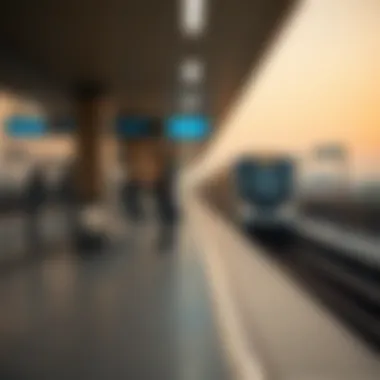Finding Your Nearest Metro Station in Dubai


Intro
Navigating a metropolitan landscape like Dubai can feel overwhelming, especially for those new to the city. With its sprawling urban setup and bustling lifestyle, knowing where to access the metro system isn't just a convenience—it can transform how you experience city life. This guide aims to empower you with the knowledge needed to identify your nearest metro station effectively, allowing you to make informed travel choices and ultimately enhancing your daily life in this vibrant city.
The metro network in Dubai isn't just a mode of transport; it's a key player in urban mobility that connects various neighborhoods, attractions, and the business hub of the city. Understanding how to determine the location of the nearest metro stations can significantly impact your daily commuting as well as your residential decisions. Whether you're a long-time resident or a newcomer, gaining insights into the metro's accessibility and its surrounding amenities will enrich your UAE experience and assist you in making practical transit choices.
Market Insights
Current Trends in Dubai Real Estate
The real estate landscape in Dubai is notably dynamic, characterized by its rapid development and constant influx of expatriates. The proximity of properties to metro stations often influences their market value, making this aspect a crucial consideration for potential investors and residents. Areas such as Dubai Marina and Downtown Dubai enjoy higher property prices due to their strategic alleys to the metro system. Investors are increasingly prioritizing accessibility when scouting for properties, recognizing that locations near metro stations tend to attract tenants and facilitate resale.
One can observe ongoing trends pointing towards increased interests in mixed-use developments adjacent to metro stations. These developments offer convenience, blending residential and commercial spaces, which appeals greatly to both investors and residents who value ease of access. Furthermore, as the Dubai metro expands with new lines and stations, the desirability and subsequent valuation of nearby properties are likely to rise.
Analysis of Property Prices and Forecasts
This year has shown a relatively stable upward trend in property prices within metro-accessible areas, particularly fueled by the anticipation of improved connectivity. Investors are advised to monitor the upcoming expansions closely, as these developments often precede a fluctuation in prices.
"Accessibility to the metro system can significantly influence property demand and pricing, potentially contributing to higher returns on investment."
Additionally, the tech-savvy nature of many expatriates drives a strong rental market in areas nearby metro stations, further heightening the potential for property appreciation.
Investment Guidance
Tips for First-Time Buyers in Dubai
For those looking into the Dubai real estate market, especially first-time buyers, considering the proximity of properties to metro stations can yield both convenience and financial benefits. Here are some practical tips:
- Research metro lines: Familiarize yourself with the existing and upcoming metro lines. Areas with new development plans often see rapid appreciation.
- Assess commute times: Evaluate how long it takes to travel from potential homes to work or leisure destinations. This will provide clarity on convenient living options.
- Consider amenities: Look for amenities around the metro stations, such as supermarkets, healthcare facilities, and gyms, which contribute to your quality of life.
Key Factors to Consider for Property Investment
When considering property investment near metro stations, keep an eye on factors such as:
- Long-term development plans: The government of Dubai frequently releases plans for urban development, and areas scheduled for expansion can offer lucrative investment opportunities.
- Surrounding infrastructure: An area’s infrastructure, including roads and schools, can drastically affect both your living experience and property value.
- Potential rental yields: Properties near metro stations often boast higher rental yield potential due to steady demand from tenants seeking convenience.
For more detailed information on Dubai's public transport, you may explore these useful resources:
Understanding the Metro System in Dubai
Navigating the city of Dubai without a grasp of its metro system can be akin to sailing without a compass. The metro, with its sleek trains zipping through the sky and underground, is not just a means of transport; it is woven into the very fabric of urban life here. For investors, homeowners, real estate agents, and expatriates, understanding this system is more than a casual interest—it’s essential for making informed decisions.
Overview of Dubai's Metro Network
Dubai's metro network is a marvel of modern engineering, boasting efficiency and reliability. With over 70 kilometers of track and numerous stations connecting key neighborhoods, it serves as a lifeline for residents and visitors alike.
The metro consists of two main lines: the Red Line and the Green Line. The Red Line runs from Rashidiya to Jebel Ali, whereas the Green Line connects Creek to Dubai Healthcare City. The integration of these lines not only aids in navigating the sprawling city but also enhances connectivity to commercial hotspots, educational hubs, and lifestyle centers. With trains arriving every few minutes, it ensures that commuters spend less time waiting and more time living their lives.
Moreover, the metro stations themselves are designed with a futuristic flair, featuring air-conditioned facilities, free Wi-Fi access, and an array of retail spots. This seamless amalgamation of convenience and comfort elevates the commuting experience significantly.
Importance of Proximity to Metro Stations
Being near a metro station isn’t just about convenience; it’s become a cornerstone of living and investing in Dubai. Proximity to metro stations can largely dictate property values and rental prices.
For home buyers and investors, a location close to a metro station is often a gold mine. Properties situated within walking distance of a metro stop tend to appreciate faster and maintain higher occupancy rates due to easy access to transportation. This is particularly attractive for expatriates who prioritize commuting efficiency.
Benefits of Proximity to Metro Stations:
- Ease of Commute: Reduced travel time means more time for personal pursuits and family.
- Attractiveness to Tenants: Properties within a short distance attract tenants looking for convenience.
- Enhanced Lifestyle Options: Being near a metro station opens up a lifestyle that includes dining, shopping, and cultural experiences without the added hassle of traffic.
- Future-Proof Investment: Real estate near transit hubs is more protected against market fluctuations as transport infrastructure typically improves over time.


In summary, a solid understanding of the metro system in Dubai can provide significant returns—whether measured in convenience, lifestyle, or financial investments. Being informed opens the door to better choices in a city known for its rapid growth and bustling life.
Locating Your Nearest Metro Station
Finding the nearest metro station is more than just a convenience; it’s often the lifeblood of urban mobility in a bustling city like Dubai. With its ever-growing infrastructure, identifying the closest metro station can save you time, reduce commuting stress, and even aid in navigating the city more efficiently. This section delves into valuable methods to help you locate your nearest metro station, ensuring you are well-equipped to make informed transit decisions.
Utilizing Online Resources
Official Metro Websites
Before the rise of mobile apps, official websites were the primary means for commuters to gather information. Official metro websites are a treasure trove of accurate details, ranging from real-time station information to maps and fare structures. One significant aspect of these sites is their comprehensive route planners.
These planners allow users to input their current location and destination, generating the best possible metro routes along with estimated travel times. It’s a practical tool that can help users navigate unfamiliar parts of the city.
However, one downside might be that these websites can sometimes be overwhelming. With a wealth of information packed into them, users might need a moment to filter through the details that matter most to them. Still, the reliability and official nature of these sites make them a preferred choice for seriously considering metro travel in Dubai.
Mobile Apps and Browsers
As technology evolves, mobile apps have taken center stage. Applications focused on public transport in Dubai are popular due to their real-time updates. Users are not just searching for stationary information; they want up-to-the-minute data about train schedules, delays, and alternative routes.
One unique feature of mobile apps is their ability to use GPS to pinpoint your exact location. This accessibility allows users to locate nearby metro stations with just a few taps. Besides that, many apps offer push notifications for service changes, ensuring users stay informed.
That said, relying too heavily on mobile apps can have drawbacks. Battery life can be an issue, and unexpected updates can sometimes lead to confusion rather than clarity. Regardless, for tech-savvy travelers, these mobile solutions are incredibly useful and complement the online resources effectively.
Physical Maps and Signage
While digital solutions are invaluable, physical maps and on-site signage shouldn't be overlooked. Maps available at metro stations offer a tactile way to understand the network layout, projecting visual representations that aid memory.
- Visible Signage: As you wander through the city or find your way to a station, clear signs often help guide you, demonstrating the distance to the nearest metro station.
- Maps on Buzzing Streets: Locations with heavy foot traffic typically feature physical maps, making it easy for pedestrians to get a grasp of their surroundings.
For some travelers, especially newcomers to Dubai, these physical elements provide a sense of assurance that digital maps sometimes lack. Having multiple tools at your disposal is essential, and combining tech-based resources with traditional methods can lead to a more comprehensive understanding of your environment—a must in a city as dynamic as Dubai.
Factors Influencing Metro Station Accessibility
Understanding the factors that influence metro station accessibility is pivotal for optimizing transit experiences in Dubai. Accessibility does not solely relate to how quickly one can reach a station but also encompasses the overall convenience and inclusivity offered to various users. Factors such as distance, infrastructure, and logistical considerations play substantial roles in determining how easy it is for individuals to access these crucial transit points.
Distance and Travel Time
Distance is a fundamental element in assessing accessibility. The closer one lives to a metro station, the more likely they are to utilize this transport option. A mere five-minutes walk can often entice commuters compared to a situation needing a twenty-minute trek. Here, geographical factors and urban layout come into play.
Also, travel time affects one’s choice. If a station is an easy jaunt away, individuals may favor public transport over private vehicles. In a vibrant city like Dubai, where traffic congestion can be a daily headache, having a metro station within walking distance can massively alter a person’s commute experience. Therefore, when searching for housing or making investment decisions, potential residents often consider the proximity of metro stations closely.
Accessibility Features for Differently-Abled Individuals
The importance of accessibility for differently-abled individuals cannot be overstated. Dubai’s commitment to inclusivity is illustrated through various adaptations in metro station design. Ramps, elevators, tactile guide paths, and special seating arrangements are just a few examples of features designed to accommodate those with mobility challenges.
Adding to that, coaching and trained staff are available to assist passengers needing help navigating the system. Such improvements not only ensure that people with disabilities can access metro services comfortably but also reflect the city’s broader commitment to inclusivity and accessibility in public spaces.
Parking Availability and Options
Parking availability is another critical factor impacting metro station accessibility. Stations with ample parking space allow car users to switch to public transport seamlessly, reducing reliance on personal vehicles. Easy parking options, like designated spaces for carpoolers or electric vehicles, can make metro access significantly more appealing.
In areas facing high demands for parking, good signage and efficient management also help streamline the experience. People will quickly determine where they can park without spending precious time searching for a spot, making the metro a much more attractive option in the end. If parking facilities are well integrated with the metro system, commuters are likely to feel more inclined to use public transport consistently.
Station Amenities and Surroundings
Understanding the various amenities and facilities available at metro stations is paramount when identifying how these elements can enhance your transit experience in Dubai. Staying close to a metro station means not only quick access to public transport but also the convenience of nearby services and shops that can make everyday life smoother. These amenities add value to the location, influencing various aspects such as property investment and urban lifestyle.
Nearby Services and Shops
Dining Options
Dining choices around metro stations contribute significantly to their appeal. Whether you're looking for a quick bite or a sit-down meal, having a variety of restaurants and cafes within walking distance is a boon. Options range from global fast-food chains to local eateries that showcase Dubai's diverse culinary scene.


An essential characteristic is accessibility—many dining spots are designed to accommodate commuters. For example, the presence of takeout options can be beneficial for those in a rush. Furthermore, cafes with free Wi-Fi can also serve as great spots for remote workers or students.
This vibrant dining culture enhances the station environment; however, it is crucial to note that peak hours might lead to crowded establishments. This could be a disadvantage if you prefer a quieter lunch or dinner setting.
Retail Stores
Let's talk about retail stores. Having shops near metro stations provides travelers and residents immediate access to essential items, from convenience store staples to specialized shops. This characteristic of public transport hubs can foster a sense of community while also promoting spontaneous shopping.
For instance, many stations feature stores like Spinneys or Carrefour, where one can grab groceries after work—this makes life easier. However, the likeliness of such amenities may depend on the specific station's location. In some cases, the presence of stores can generate chronic congestion as commuters flock to these convenient outlets, especially during weekends or holidays.
Community Services
Community services around metro stations contribute to improving the overall transit experience. These can range from health clinics to community centers and educational facilities. The presence of these services highlights the metro stations' roles as community hubs, not just transport locations.
Having such services available means an added convenience. For example, a medical clinic nearby ensures that health needs can be addressed promptly. However, while community services can cater to essential needs, their limited operating hours could render them inaccessible for late-night commuters.
Public Safety and Security Measures
Safety is a vital consideration when using metro services. Thus, it is essential to consider the security measures in place at each station. Stations deploy surveillance systems, trained security personnel, and emergency protocols designed to ensure the safety of passengers. High levels of awareness and accessibility to assistance create a comforting atmosphere, allowing travelers to focus on their journey rather than their safety.
Integration with Other Transit Systems
In urban conglomerates like Dubai, where a tapestry of cultures intertwines, public transit must be more than just a series of stops and starts. The integration of metro stations with other transit systems—namely buses, trams, and even ride-sharing services—enriches the public transportation landscape. Understanding how these systems work in tandem is key for effective navigation and optimal urban mobility.
Seamless transitions between different modes of transport are crucial, particularly in a city where daily commuting can be quite a challenge. Discovering how quickly one can switch from the metro to a bus or tram can make all the difference. It’s about efficiency, convenience, and ultimately delivering a user experience that encourages more residents and visitors to rely on public transport altogether.
Complementary Bus and Tram Services
Dubai’s metro system boasts an impressive infrastructure, but it is the complementary bus and tram services that ultimately extend its reach. The city’s buses operate on an extensive network, filling the gaps that the metro cannot cover directly. Almost every metro station is flanked by bus stops, creating a convenient overlap that allows passengers to continue their journey without missing a beat.
Here’s how these services enhance accessibility:
- Frequent Departures: Buses run at regular intervals, reducing waiting time.
- Wide Coverage: Bus routes zigzag through neighborhoods, allowing access to areas that metro lines may not reach.
- Unified Fare System: Whether you are hopping on a tram, bus, or metro, a single fare card often covers all transit modes, simplifying the journey.
Additionally, Dubai's tram system complements the metro beautifully by connecting popular areas like Jumeirah Beach and the Dubai Marina. This system makes it much easier to reach destinations that lie front and center in the city’s tourist and commercial hubs.
Bicycle and Ride-Sharing Options
With the increasing focus on sustainability, the availability of bicycle options and ride-sharing services around metro stations has become an important factor in urban transit.
Bicycles provide another alternative for those who prefer two wheels to four. Many metro stations feature bike racks and even designated paths leading to key transport hubs. For the environmentally conscious commuter, cycling not only reduces the carbon footprint but also offers a brisk workout to start the day.
On the other hand, ride-sharing services like Uber or Careem seamlessly integrate with metro travel, offering flexible options when waiting for public transport isn’t ideal. Whether you’re heading home after a late-night out or rushing to meet a business associate, these services bridge the final leg of your journey.
As you can see, the synergy between metro services, buses, trams, bicycles, and ride-sharing brings about a holistic approach to travel. By fully utilizing these interconnected options, commuters can reduce travel time, improve convenience, and create a more satisfying urban transport experience overall.
“Integration of different transport modes is not just a technical necessity; it's about creating a commuter-friendly atmosphere that invites all.”
What does all of this mean for property investors and potential homeowners? The locations of metro stations alongside well-integrated transit options invariably influence property values, signaling growth opportunities in well-connected neighborhoods.
For those looking to find the best spots in Dubai, understanding how these different systems interact is imperative, ensuring that you’re not just investing in property, but in a lifestyle. To learn more about investing in transit-rich areas, check out relevant insights on platforms like MultiHousingNews and local government resources at Dubai Land Department.
Implications for Property Investment
In the bustling urban environment of Dubai, the proximity of real estate to metro stations significantly influences property values. Understanding the implications of this can provide investors, homeowners, and developers with crucial insights into market dynamics. The connectivity offered by the metro system often increases the desirability of properties located nearby. With easy access to public transport, properties near metro stations tend to attract renters and buyers alike, making them a sound investment choice.
Some core aspects to consider include:
- Increased Demand: With many residents prioritizing accessibility when choosing where to live, properties situated close to metro stations usually experience higher demand. This demand can lead to increased rental income and potentially appreciate property values over time.
- Market Stability: Properties near metro stations often showcase better resilience during economic downturns. The amenities and transport connections contribute to a more stable real estate market, as individuals prioritize convenience and commute ease.
- Future Developments: Investors should keep an eye on announcements regarding new metro lines or station expansions. Increased connectivity forecasts growth in terms of local economy, which often translates to rising property values.
A well-considered strategy when investing in properties near metro stations can have long-lasting benefits.


Valuation of Properties Near Metro Stations
The valuation process for properties near metro stations is multifaceted. Factors influencing these valuations often include location, accessibility, and future development potential.
- Location: Properties that are a stone's throw away from metro stations are often viewed as prime real estate. The closer the distance, the higher the perceived value.
- Access to Amenities: Beyond just the metro, nearby amenities like shops, restaurants, and parks contribute to property valuations. A vibrant environment can attract more prospective buyers or renters.
- Market Analysis: Utilizing comparative market analysis to understand how similar properties are priced can yield valuable insights. Investors should assess the direct relationships between metro proximity and rental prices.
- Sustainability Factors: Buyers are increasingly considering eco-friendly elements in their purchasing decisions. Properties close to metro stations often see increased interest as they promote sustainable transport solutions.
Understanding these elements can allow potential investors to predict market behaviors more accurately, helping them make informed decisions about property purchases or sales.
Buyer Preferences and Market Trends
In today's market, buyer preferences are shifting dynamically. Accessibility and convenience have become paramount in influencing purchasing decisions. Trends show that potential homebuyers are prioritizing locations that not only offer proximity to metro stations but also an overall balance of lifestyle and accessibility.
- Trend towards Urban Living: An increasing number of individuals, especially millennials and expatriates, prefer urban living with easy access to transportation. Metro systems in Dubai play a vital role in this, affecting property demand and pricing.
- Amenities as Key Criteria: Buyers are now keen on properties that provide not just basic utilities but also additional services like grocery stores, fitness centers, or cafes in proximity to metro stations.
- Long-Term Investment Outlook: Investors, particularly those looking for long-term gains, are inclined towards properties that promise stability and growth. Being close to a metro station is often seen as a guarantee for future appreciation.
These evolving market trends show that understanding the implications of property investment near metro stations is increasingly crucial for making informed choices in Dubai's real estate landscape.
"Investing in properties close to metro stations not only enhances lifestyle options but also serves as a strategic move in a fluctuating market," says a leading market analyst.
For further resources on property investment in Dubai, one may consult Dubai Land Department or The National for up-to-date property trends and market analyses.
Case Studies of Notable Metro Stations
In the bustling metro landscape of Dubai, certain stations have become more than just stops on a line; they signify a blend of accessibility, community, and economic potential. By examining case studies of notable metro stations, stakeholders can glean valuable insight that influences both mobility choices and investment decisions.
Popular Residential Areas Around Specific Stations
The extent to which a metro station enhances nearby residential areas often determines its popularity and desirability. For instance, the Dubai Marina station serves an affluent neighborhood filled with luxury apartments. Its close proximity to waterfront attractions and vibrant retail options attracts a mix of investors and renters seeking easy access to work and leisure.
Similarly, the JLT (Jumeirah Lake Towers) station opens a gate to a community buzzing with life. The green parks and diverse dining options nearby create a compelling living environment, making it a sought-after locality for expatriates hoping to balance work with a quality lifestyle. Property values around such stations typically reflect their desirability, with an upward trend noted over the years.
Factors worth noting in these regions include:
- Demographics: Understanding age, income levels, and family sizes helps identify who might lean towards living close to a metro station.
- Amenities: Proximity to entertainment, supermarkets, and schools becomes pivotal for families looking for long-term stays.
- Local Culture: The vibrancy of a neighborhood can enhance interest from locals and expatriates alike, shaping the local economy and lifestyle.
Station Effect on Local Economies
The impact of metro stations reaches far beyond just facilitating transportation. Financially, stations can invigorate local economies through increased foot traffic. Businesses flourish in bustling areas; coffee shops, retail stores, and services like salons often benefit from the visibility and accessibility provided by nearby stations.
A prime example is the Burj Khalifa/Dubai Mall station, which has significantly driven growth in commercial activity around the iconic shopping destination. Here, the influx of tourists and residents encourages diverse economic activities, from tourism to hospitality.
"Metro stations act as catalysts for community development, knitting together residential pockets and enhancing economic opportunities."
Consider the following points regarding economic effects:
- Job Creation: New businesses align with metro stations, providing jobs to locals and utilizing nearby talent.
- Increased Property Values: Areas showcasing high accessibility often see property values rise as demand grows.
- Public Investment: Enhanced infrastructure brings in public and private investments, showing the direct correlation between transit and local economic health.
Future Developments and Upgrades to Metro Stations
In the ever-changing landscape of urban mobility, future developments and upgrades to metro stations carry significant weight. For Dubai, a city synonymous with innovation and futuristic visions, these enhancements not only promise to elevate the transit experience but also reflect the aspirations of its residents and visitors. Looking at the metro system, we can appreciate how these planned changes can revitalize neighborhoods, improve accessibility, and rise property values in the vicinity of stations. As we venture further, let’s dive into what these expansions and new stations actually mean for commuters and investors alike.
Expansions of Existing Lines
When one thinks of a city’s metro system, it’s akin to a living organism, continuously adapting and expanding to meet the demands of an ever-growing population. In Dubai, the decision to expand existing metro lines stems from practical needs as well as strategic urban planning. Expansions enhance connectivity, reducing travel time and increasing the efficiency of the metro network.
The upcoming extension of the Red Line, which will take it deeper into new residential and commercial areas, is expected to add substantial convenience for commuters. One can imagine a family moving from a distant suburb closer to the city center, now able to dart to work or leisure without the hassle of long drives. This not only promotes environmental sustainability by decreasing reliance on vehicles but can also lead to a surge in property investments as neighborhoods see increased foot traffic and businesses flourish nearby.
Moreover, upgrades aren’t limited to just extending lines; modernizing stations with advanced technology for ticketing and real-time updates can significantly affect user experience. Smart systems, complete with digital signage and automated notifications, are examples of factors that elevate the commuter's journey.
Emergence of New Stations
In addition to expanding existing lines, the emergence of new metro stations is a crucial component of enhancing the metro network. Each new station represents more than just a stop on the map; it embodies a nod to future urban development plans and is often accompanied by new opportunities for economic growth.
For instance, one can explore areas where new stations are scheduled to open and observe how these developments are drawing interest from real estate developers eager to capitalize on increased traffic and accessibility. The proposed metro station at Al Maktoum International Airport, for example, is a game-changer. The thought of a seamless flow of passengers directly from the airport to the heart of Dubai shifts the dynamics not just for tourism but also for business travel, presenting a unique opportunity for businesses in hospitality and services.
"The effectiveness of a metro system in any growing city hinges not only on its efficiency but also on how adeptly it can expand to meet future demands."
A clear understanding of these developments is essential for investors and homeowners alike. As they map out potential future investments, evaluating proximity to new stations becomes a crucial aspect of their decision-making. As the metro evolves, so does the value found in neighborhoods that can offer commuters and visitors swift access to the broader cityscape.
To summarize, the world of metro developments is not merely about tracks and trains; it’s about the repercussions these infrastructures bear on property dynamics, community accessibility, and economic solutions in the bustling heart of Dubai. Keeping an eye on these developments can unlock a universe of potential for both daily commuters and savvy investors.







